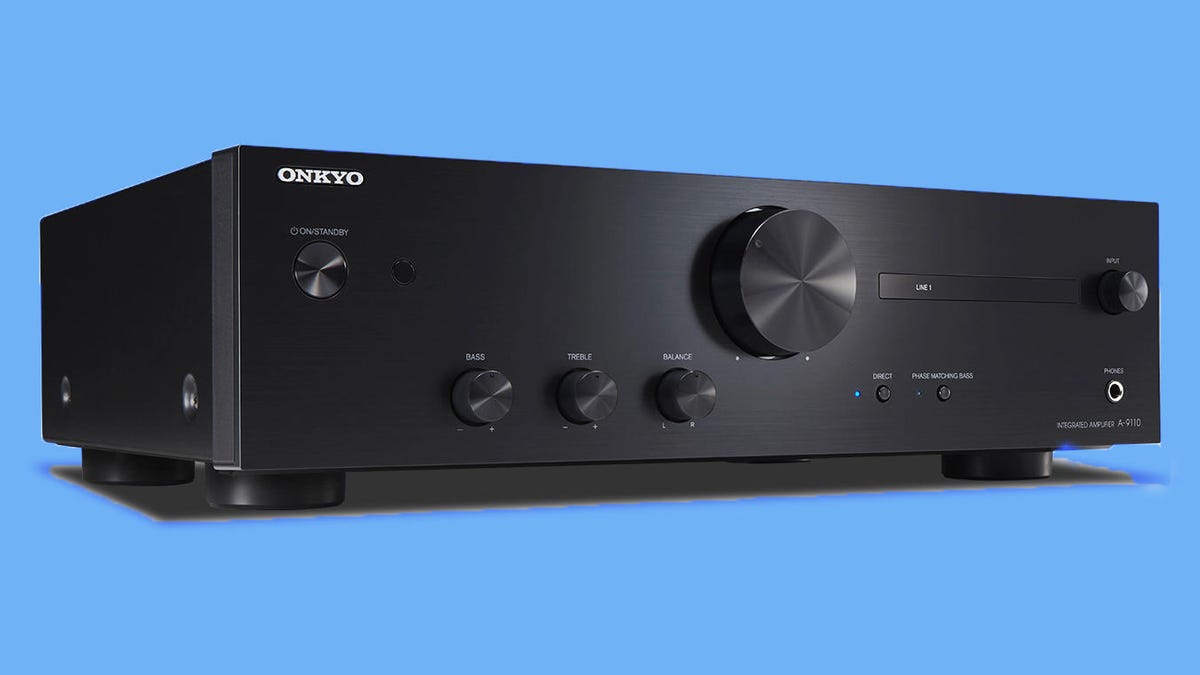Onkyo aims high with its new low price amplifier
The no-frills Onkyo A-9110 puts the emphasis on sound, not features, says the Audiophiliac.

The Onkyo A-9110 stereo integrated amplifier.
It's late in 2018 so I wasn't expecting this, an all-analog stereo integrated amplifier from Onkyo. The company's keep-it-simple approach is refreshing and makes a lot of sense because while analog audio hasn't changed much over the past half century, digital formats can change from one year to the next. The A-9110 sells for $349 in the US, £230 in the UK the Australia price has not yet been announced but converts to AU$493.
That's not to say the A-9110 can't play digital sources, just hook up any CD player's analog outputs or a computer's headphone jack to the A-9110's analog inputs. Or buy an external digital converter to hook up to your computer's USB port and let the converter, such as the Schiit Audio Modi 3 ($99, £119, AU$209), send analog audio to the A-9110.
The utter simplicity of the design makes it a breeze to setup and use, two things you can't count on with consumer electronics anymore. The A-9110 is as plug and play as audio gets, the uncluttered design should wear well over the years.
The Onkyo A-9110's rear panel.
The A-9110's connectivity runs to four sets of stereo RCA inputs, plus a moving–magnet phono input for turntables. There's also one stereo line output for a tape recorder, an RCA subwoofer jack and a 6.3mm headphone jack on the front panel. The five-way binding posts for speaker wires are nice and sturdy.
As for power, the A-9110 is rated at 30 watts per channel for 8 ohm speakers, 50 watts per channel with 4 ohm speakers. Unlike most affordable amps that are Class D designs, the A-9110 is a higher quality Class AB design. It's no coincidence most of my favorite amps are Class AB designs.
Instead of a "loudness" control that boosts deep bass the A-9110 has a Phase Matching Bass control that seems to work just like a loudness control. It comes in handy with small speakers with lightweight bass. I also like that the A-9110 also has bass and treble controls, feel free to tweak the sound of recordings to your taste.
The sound of disc 7 from R.E.M.'s just dropped Live at the BBC box set blew me away. The 1991 show from the Pyramid Stage at the Glastonbury Festival had tons of atmosphere, Michael Snipe was on fire, and the energy level of the band floored me.
With James Carter's Organ Trio's At the Crossroads album, I compared the A-9110 with my old NAD C-316BEE integrated amp. It's also an all-analog, Class AB design. Right away the A-9110 was the more vibrant and clearer amp, the C 316BEE was a sweeter, tonally richer sounding beast. I like both, but they sound surprisingly different. I listened mostly over my Emotiva Airmotiv B1 bookshelf speakers, but I also played the A-9110 with a set of KEF LS50 speakers and heard the similar differences between the two amps.
The A-9110's firm grip on the LS50s woofers was mighty impressive when I played acoustic guitarist Leo Kottke's That's What album. Billy Peterson's five string acoustic bass sound was bold and still remarkably clear, and Kottke's big baritone vocals were full throated too. The A-9110 let this very natural sounding recording shine.
The Onkyo A-9110 is exactly the sort of stereo integrated amp I recommend to novices who are just beginning their audiophile journey. Match it with a set of Emotiva Airmotiv B1 or Elac Debut B6.2 speakers and you'll be off to a great start.
Engineer Al Schmitt explains how he won 20 Grammys: Schmitt made his mark first by listening to the needs and wants of the musicians he's recorded, and then making them sound great.
Grado's first Bluetooth headphone signals a change of direction: The Grado GW100 is the first open-back Bluetooth headphone we've tested, maybe that's why is sounds so open and spacious!

